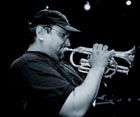
|
|
|
|
|
|
Photo Credit: Jeffrey Kliman |
Ray Vega
Raised in the South Bronx by Puerto Rican parents, Ray Vega grew up speaking both Spanish and English. When it comes to music, he's equally bilingual. Vega can shift effortlessly between jazz and Latin styles thus producing a highly personal sound. A true musical melting pot, he also incorporates elements of pop, rock, and R & B. Vega brings this unique voice to the Kennedy Center when he joins Dr. Billy Taylor for a little conversation and a set of jazz standards. Whether playing the trumpet or flugelhorn, Vega's personal and musical warmth always shines through. The show opens with "There Will Never Be Another You," performed at an elegant mid-tempo by the ensemble. Vega then tells Dr. Taylor about his upbringing and how he listened to all types of music on the radio: R & B, funk, boogaloo, rock and Latin. An older brother turned Vega on to big band music and opened the door to a life-long love of jazz. Something about the music appealed to Vega as a youngster. "I saw Jackie McLean on a TV show called Like It Is," he says. "I was just a child then, but it felt magnificent." Some of Vega's earliest gigs were with local salsa bands, and eventually he performed with Latin jazz luminaries Mongo Santamaria and the late Tito Puente. "Playing with Puente was a gas," Vega says, "He was the youngest 77-year-old person on the planet!" An energetic bandleader, Puente took Latin jazz to fans all over the world; Vega traveled with him through Europe, the Americas, and Southeast Asia. Every night the Puente band would open with a mambo number and follow it with Claire Fisher's "Morning." Vega and Dr. Taylor honor Puente's memory by performing the Latin-tinged tune for the Theater Lab audience. On "Morning" Vega plays trumpet and flugelhorn, so Dr. Taylor asks him what the difference between the instruments. Vega explains that both horns have the same length of tubing, but the diameters are different. The trumpet's tubing is cylindrical with a constant diameter. The flugelhorn, like the cornet, has conical tubing that widens along its length. The tubing and a wider and thicker bell give the flugelhorn a darker sound than the trumpet. Dr. Taylor then wonders if Vega changes his style when playing Latin music. He says he keeps the same embouchure, but attacks and colors notes slightly differently. Unaccompanied, Vega demonstrates how jazz trumpet usually has less vibrato than Latin-style trumpet and a cooler tone. He then launches into a lovely rendition of the ballad, "What's New." An audience member asks Vega about improvising and how far in advance he plans his solos. Vega says he puts himself in the "zone" "I try to forget about everything around me. You have to free your mind and surrender yourself." He concedes that all musicians have stock licks on which they rely, but studying and listening foster new ideas. Vega tells Dr. Taylor that some of his biggest influences were jazzmen like Dizzy Gillespie and Bill Hardman and salsa players like Roberto Rodriguez. Another favorite is Miles Davis, and Vega pays ample tribute with "So What." A Bronx native in the audience asks Vega to expound on the clave and the importance of polyrhythms in jazz. Vega explains that the clave is a rhythmic pulse that sprang up in Africa and the Mediterranean before coming to the New World. Vega claps out the rhythm and as the audience follows, the quartet improvises over the distinctly Latin groove. To close the show, the group takes on a more familiar groove, Milt Jackson's classic blues "Bag's Groove." With his special blend of swing and good humor, Vega makes it distinctly his own.
|
|
| |
